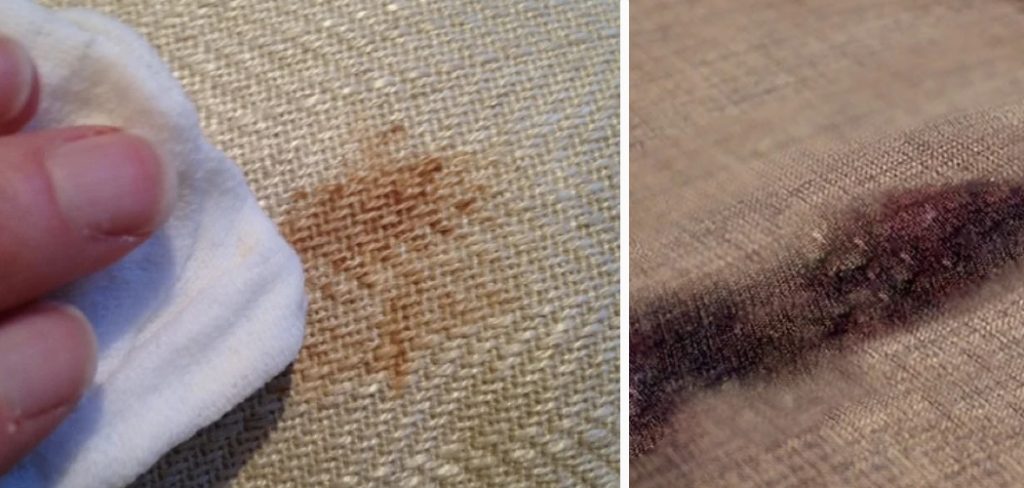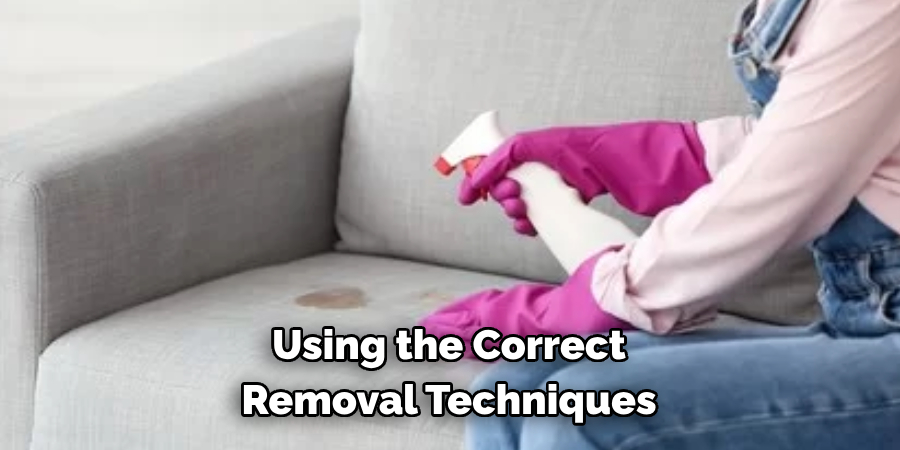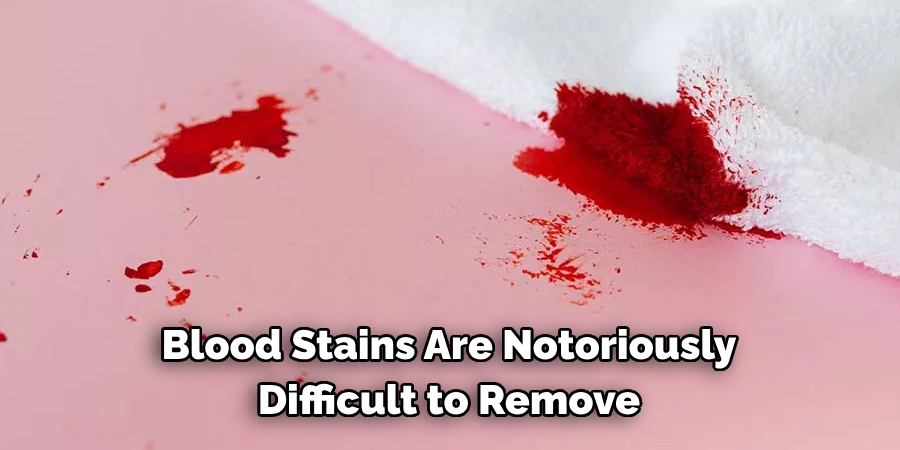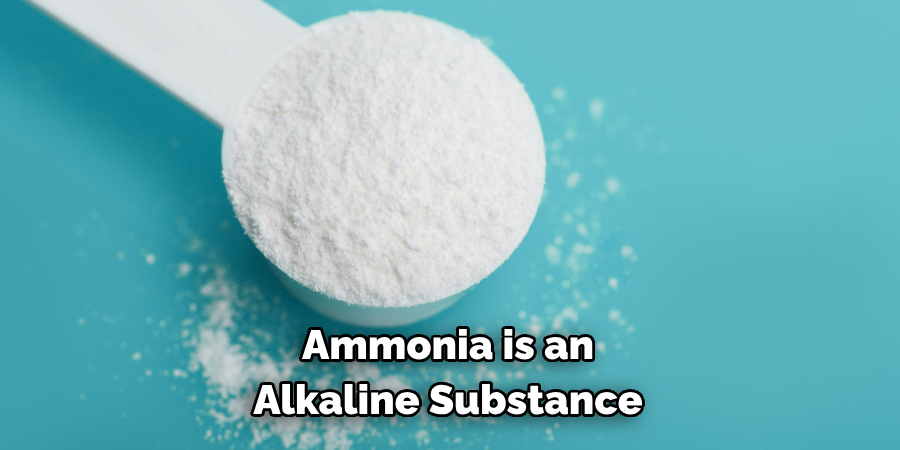Removing blood stains from a fabric sofa can be a challenging task, but with the right techniques and products, it’s entirely possible to restore your furniture to its pristine condition. Whether the blood stains are fresh or have set in, prompt action is essential to effectively lift the stain without damaging the fabric. In this article, we’ll explore various methods for how to get blood off fabric sofa.

From gentle cleaning solutions and natural remedies to specialized stain removers and laundering techniques, we’ll provide step-by-step instructions and expert tips to help you tackle even the most stubborn blood stains. With the right approach and a bit of patience, you can successfully eliminate blood stains from your fabric sofa and preserve its appearance and integrity for years to come.
Importance of Prompt and Proper Removal
Acting swiftly and using the correct removal techniques are crucial when dealing with blood stains on fabric sofas. Prompt action increases the chances of completely removing the stain, as blood begins to set and becomes more challenging to remove once it dries.
Additionally, employing the right method ensures that the fabric is not damaged in the process. Improper cleaning techniques or harsh chemicals can lead to the sofa’s fabric fading, disintegrating, or permanently setting the stain, exacerbating the issue. Understanding the fabric type and selecting an appropriate cleaning solution is essential for maintaining the sofa’s aesthetic and structural integrity while effectively eliminating the blood stain.
Understanding Blood Stains on Fabric
Blood stains are notoriously difficult to remove due to the composition of blood itself. Blood contains hemoglobin, which, when exposed to air, binds to the fabric fibers, making removal challenging. The complexity of dealing with blood stains increases with the time the stain has been left untreated; fresh stains are invariably easier to manage than those that have set.
Understanding the chemical makeup of blood and how it interacts with fabric fibers is critical in choosing the most effective cleaning strategy. Different types of fabric react differently to water and cleaning agents, meaning a one-size-fits-all approach does not exist. Natural fibers like cotton and linen may require different treatment compared to synthetic fabrics such as polyester or nylon. Thus, identifying the fabric type of your sofa is a crucial first step in successfully removing blood stains without causing damage.
Composition of Blood and Its Interaction with Fabric
Blood’s unique composition directly influences its interaction with fabric, making it a particularly stubborn type of stain to remove. At its core, blood is made up of water, proteins, enzymes, and red cells, each playing a role in how the stain bonds to the fabric. The proteins and enzymes in blood can denature and coagulate when exposed to heat or certain chemical treatments, causing the stain to bind more firmly to the fabric fibers. This is why cold water is often recommended for initial treatment of blood stains rather than hot water, which can set the stain more deeply into the fabric.

Additionally, the physical structure of different fabric types affects how blood stains can be treated. For example, tightly woven fabrics might prevent the stain from penetrating deeply but make surface treatment more challenging. In contrast, more porous fabrics may absorb the stain quickly, spreading it over a larger area but potentially allowing for easier removal if treated promptly and correctly. Understanding these interactions is pivotal in selecting the appropriate method for blood stain removal from a fabric sofa.
Risks of Improper Cleaning Methods
Employing incorrect cleaning methods to remove blood stains from fabric sofas can have adverse effects, potentially causing irreparable damage to the furniture. The use of inappropriate chemicals or techniques may not only fail to remove the blood stain but could also lead to discoloration, fading, or weakening of the fabric. For example, harsh chemicals like bleach can break down fabric fibers or cause color loss, especially in natural fabrics such as cotton or linen. Similarly, excessive rubbing or scrubbing can fray the fabric or spread the stain further.
It’s also important to note that high heat from steam cleaning or using a hot water rinse can permanently set the stain, making it nearly impossible to remove. Understanding the delicate balance between effective stain removal and preserving the integrity of the sofa fabric is key to avoiding these pitfalls and maintaining the appearance and lifespan of your furniture.
Identifying Fresh vs. Set-In Stains
Differentiating between fresh and set-in blood stains is crucial for determining the most effective cleaning approach. Fresh stains are typically easier to handle because the blood has not yet bonded completely with the fabric fibers. These stains often appear bright red and can be blotted up with minimal effort. On the other hand, set-in stains have had time to dry and oxidize, often turning a darker color and adhering more firmly to the fabric.

Identifying the age of the stain is simple: if it’s still damp or has occurred within a few hours, it’s considered fresh. Stains that have been left for more than a day are likely set-in, requiring more intensive treatment methods. The approach to cleaning will vary significantly depending on whether you are dealing with a fresh stain or a set-in one, highlighting the importance of correctly identifying the stain type from the outset.
10 Methods How to Get Blood off Fabric Sofa
Method 1: Act Quickly
The key to successfully removing blood stains from a fabric sofa is to act quickly. As soon as you notice the stain, blot it with a clean, dry cloth or paper towel to absorb as much of the blood as possible before it sets into the fabric. Do not rub the stain, as this will only spread it and make it more difficult to remove.
Once you have blotted up as much of the blood as possible, mix a solution of equal parts cold water and hydrogen peroxide. Pour or spray the solution directly onto the stain, then use a clean cloth to gently dab at the stain. Be sure to work from the outside of the stain towards the center to avoid spreading it further.
If the blood stain is particularly stubborn, you can also try using a mixture of liquid dish soap and cold water. Mix one tablespoon of dish soap with two cups of cold water, then use a clean cloth to gently dab at the stain. Rinse the area thoroughly with cold water and blot dry.

Method 2: Cold Water Rinse
For fresh blood stains, start by rinsing the affected area with cold water. Cold water helps prevent the blood from setting into the fabric and makes it easier to remove. Use a clean cloth dampened with cold water to gently blot the stain, working from the outside in to prevent spreading. Avoid using hot water as it can actually make the stain more difficult to remove.
Next, apply a small amount of liquid detergent directly onto the stain and gently rub it in with your fingers. Let it sit for about 10-15 minutes before rinsing again with cold water. You can also use a pre-treatment stain remover or a mixture of equal parts white vinegar and cold water to help break down the stain.
After rinsing, check if the stain is still visible. If it is, repeat the process until it disappears. Once the stain is no longer visible, you can wash the item as usual according to its care instructions.

Method 3: Use Hydrogen Peroxide
Hydrogen peroxide is a gentle yet effective stain remover that can help lift blood stains from fabric. Mix one part hydrogen peroxide with two parts cold water and apply the solution to the stained area using a clean cloth or sponge. Blot the stain gently, taking care not to rub it further into the fabric. Rinse the area with cold water and repeat the process as needed until the stain is lifted.
Hydrogen peroxide is also a natural whitener and can help remove any residual discoloration from the blood stain. It is safe to use on most fabrics, but it’s always a good idea to do a patch test on an inconspicuous area first.
To improve the effectiveness of this method, you can add a few drops of dish soap or liquid laundry detergent to the hydrogen peroxide solution. This can help break down any proteins in the blood and make it easier to remove.
Method 4: Make a Paste with Baking Soda
Baking soda is another natural remedy that can help remove blood stains from fabric. Mix baking soda with a small amount of cold water to create a thick paste. Apply the paste to the stained area and let it sit for about 15-30 minutes to allow the baking soda to absorb the blood. Afterward, gently scrub the paste with a soft brush or cloth and rinse the area with cold water. Repeat if necessary until the stain is completely gone.
Baking soda works by neutralizing the acidic components in blood, making it easier to remove from fabric. It is also safe for most types of fabric and does not cause any discoloration or damage.
In addition to removing blood stains, baking soda paste can also be used as a natural deodorizer and cleaner. It can be used to deodorize carpets, remove tough stains from kitchen appliances, and even clean grout.
Method 5: Apply Liquid Dish Soap
Liquid dish soap is effective at breaking down and lifting protein-based stains like blood from fabric. Apply a small amount of liquid dish soap directly to the stained area and gently massage it into the fabric using your fingers or a soft brush. Let the soap sit for a few minutes, then rinse the area with cold water. Repeat this process until the stain is no longer visible.
An added bonus of using liquid dish soap is that it can also help remove any lingering odor from the stained fabric. This method is especially useful for removing blood stains from clothing or linens, as these types of fabrics are often delicate and require a gentle yet effective cleaning solution.

However, it’s important to note that not all liquid dish soaps are created equal. Some may contain harsh chemicals that can damage certain types of fabric or cause skin irritation. It’s best to choose a mild and gentle dish soap specifically designed for hand washing dishes, as these are less likely to cause any adverse reactions.
Method 6: Try Enzyme-Based Stain Remover
Enzyme-based stain removers are specifically formulated to break down organic stains like blood. Apply the enzyme-based stain remover to the stained area according to the manufacturer’s instructions and let it sit for the recommended amount of time. Use a clean cloth to blot the stain, working from the outside in, and rinse the area with cold water. Repeat the process until the stain is completely gone.
Enzyme-based stain removers are a great option for removing blood stains because they use natural enzymes to break down and remove the proteins in the blood. These products are also safe to use on most fabrics and surfaces, but it’s always a good idea to test the product on a small, inconspicuous area first.
In addition to using enzyme-based stain removers, there are a few other tips that can help remove blood stains effectively. For fresh stains, it’s important to act quickly and try to absorb as much of the stain as possible before it sets in.
Method 7: Use Ammonia Solution
Ammonia is an alkaline substance that can help break down and dissolve blood stains from fabric. Mix one tablespoon of household ammonia with one cup of cold water and apply the solution to the stained area using a clean cloth or sponge. Blot the stain gently, then rinse the area with cold water to remove any residue. Repeat this process until the stain is no longer visible.

Ammonia solution can also be used to remove other types of stains, such as sweat and urine. For these types of stains, mix equal parts ammonia solution and water and apply it directly onto the affected area. Let it sit for a few minutes before blotting and rinsing with cold water.
It’s important to note that ammonia solution should not be used on silk, wool or leather as it can cause damage. Also, make sure to work in a well-ventilated area and avoid skin contact with the solution.
In addition to its stain-removing properties, ammonia solution can also be used as a natural cleaner for various surfaces. Dilute one part ammonia with four parts water and use it to clean windows, mirrors, and other glass surfaces. It can also be used to remove grease and grime from kitchen appliances and countertops.
Method 8: Apply Salt Paste
Salt can help absorb moisture and lift blood stains from fabric. Mix salt with a small amount of cold water to create a thick paste and apply it to the stained area. Let the salt paste sit for several hours or overnight to allow it to absorb the blood. Afterward, brush off the dried salt paste and rinse the area with cold water.
Method 9: Use White Vinegar Solution
White vinegar is a natural acid that can help break down and lift blood stains from fabric. Mix equal parts white vinegar and cold water in a spray bottle and apply the solution to the stained area. Let it sit for a few minutes, then blot the stain with a clean cloth. Rinse the area with cold water to remove any vinegar residue. Repeat the process until the stain is completely gone.
White vinegar can also be used in conjunction with other methods, such as salt or baking soda, for tougher blood stains. Sprinkle some salt onto the stained area and then pour white vinegar over it. Let it sit for a few minutes before scrubbing with a toothbrush. Rinse with cold water and repeat if necessary.
Method 10: Launder the Fabric
For removable fabric covers or cushion covers, laundering them in the washing machine can help remove stubborn blood stains. Pre-treat the stained area with a stain remover or laundry detergent, then wash the fabric covers in cold water with a mild detergent. Avoid using hot water, as it can set the stain into the fabric. Hang the fabric covers to air dry or tumble dry them on a low heat setting.

Conclusion
In conclusion, effectively removing blood stains from a fabric sofa requires prompt action and the right techniques. By assessing the stain’s freshness, fabric type, and employing appropriate cleaning methods, individuals can successfully restore the sofa’s appearance and maintain its cleanliness.
Whether using cold water and mild detergent, hydrogen peroxide solution, or enzyme-based stain removers, it’s crucial to approach the removal process with care and attention to detail. Verifying the stain removal and addressing any residual marks or discoloration ensures a thorough and satisfactory outcome. Thanks for reading, and we hope this has given you some inspiration on how to get blood off fabric sofa!
Huston Douthit is a distinguished figure in the world of furniture design, with a decade of expertise creating innovative and sustainable furniture solutions. His professional focus lies in merging traditional craftsmanship with modern manufacturing techniques, fostering designs that are both practical and environmentally conscious. As the author of Fruniturix, Huston delves into the art and science of furniture-making, inspiring artisans and industry professionals alike.
Education
- RMIT University (Melbourne, Australia)
Associate Degree in Design (Furniture)- Focus on sustainable design, industry-driven projects, and practical craftsmanship.
- Gained hands-on experience with traditional and digital manufacturing tools, such as CAD and CNC software.
- Nottingham Trent University (United Kingdom)
Bachelor’s in Furniture and Product Design (Honors)- Specialized in product design with a focus on blending creativity with production techniques.
- Participated in industry projects, working with companies like John Lewis and Vitsoe to gain real-world insights.
Publications and Impact
In Fruniturix, Huston shares his insights on furniture design processes, materials, and strategies for efficient production. His writing bridges the gap between artisan knowledge and modern industry needs, making it a must-read for both budding designers and seasoned professionals.


